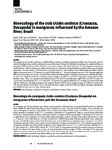Please use this identifier to cite or link to this item:
http://www.alice.cnptia.embrapa.br/alice/handle/doc/984889| Title: | Bioecology of the crab Ucides cordatus (Crustacea, Decapoda) in mangroves influenced by the Amazon River, Brazil. |
| Authors: | AMARAL, K. D. S.  VIEIRA, I. M.   OSÓRIO, F. M.   ROCHA, J. D. M.   LIMA, J. de F.   |
| Affiliation: | KARLIA DALLA SANTA AMARAL, CPAF-AP INÁCIA MARIA VIEIRA, Instituto de Pesquisas Científicas e Tecnológica do Estado do Amapá FREDERICO MOREIRA OSÓRIO, Instituto Brasileiro do Meio Ambiente e dos Recursos Naturais Renováveis JOANA D'ARC MAURICIO ROCHA, Universidade do Estado do Amapá JO DE FARIAS LIMA, CPAF-AP. |
| Date Issued: | 2014 |
| Citation: | Acta Amazonica, Manaus, v. 44, n. 2, p. 213-222, 2014. |
| Description: | The mangrove crab (Ucides cordatus) is a valuable fishery resource, overfished along the Brazilian coast. This study aimed to obtain bioecological data on this crab along the coast of the State of Amapá. Six bimonthly samplings were conducted between December 2008 and January 2010. Transects were used to estimate the density (burrows m-2) and population abundance (individuals m-2). All the animals were subjected to biometrics, with females being classified according to their stage of gonadal maturation. The mean density (1.09 burrows m-2) and abundance (0.31 individuals m-2) were influenced by the climate with the highest values ​​in summer (1.17 burrows m-2 and 0.34 individuals m-2). The male to female ratio was 1.38:1 showing significant difference in the proportion of sexes. The individuals showed sexual dimorphism, with linear measurements significantly higher in males. The sampled animals also had larger carapace length and width (CL and CW) compared to crabs studied in other Brazilian states. There was a positive relationship between CW and CL and individual weight (IW) and CW for males (R2 = 0.83 and 0.90) and females (R2 = 0.79 and 0.84). The growth was negative allometric (CL increases to a lesser extent than CW) for both sexes. The highest frequency of ovigerous females (78%) and in maturation stage IV (38%) occurred in the CW size class between 59.8 and 67.5 mm. The peak of mature females occurred in May and August, showing a reproductive period different from those in other Brazilian states. |
| Thesagro: | Crustáceo Recurso pesqueiro |
| NAL Thesaurus: | population structure |
| Keywords: | Reprodutctive dynamics Fishery resource Dinâmica reprodutiva Estrutura populacional Amapá |
| Type of Material: | Artigo de periódico |
| Access: | openAccess |
| Appears in Collections: | Artigo em periódico indexado (CPAF-AP)  |
Files in This Item:
| File | Description | Size | Format | |
|---|---|---|---|---|
| CPAFAP2014Bioecologyofthecrab.pdf | 745,07 kB | Adobe PDF |  View/Open |









